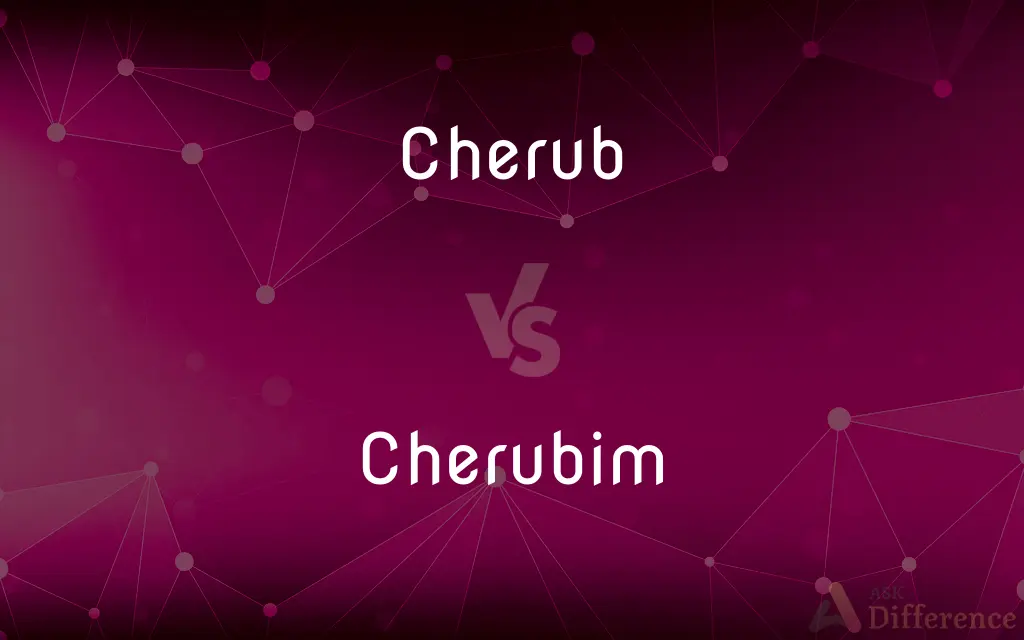Cherub vs. Cherubim — What's the Difference?
By Urooj Arif & Fiza Rafique — Updated on April 6, 2024
A cherub is a singular celestial being depicted as innocent and childlike in art, whereas cherubim refer to the plural form, often described in biblical texts as powerful creatures with multiple wings and faces.

Difference Between Cherub and Cherubim
Table of Contents
ADVERTISEMENT
Key Differences
A cherub represents a single entity within the hierarchy of angels, often portrayed in Renaissance art as a chubby child with small wings, embodying innocence and divine watchfulness. This depiction emphasizes the cherub’s role as a guardian and a symbol of purity. Cherubim, on the other hand, are the plural form of cherub, denoting a group of these celestial beings. In biblical and theological contexts, cherubim are described with awe-inspiring attributes, including multiple wings and faces, signifying their power, knowledge, and proximity to the divine.
The artistic representation of cherubs in Western art contrasts significantly with the original descriptions found in religious texts. While cherubs are commonly depicted as gentle and childlike figures, cherubim in scripture are powerful and multifaceted creatures that guard sacred spaces and serve God directly. This distinction highlights the evolution of the cherub’s image from a formidable guardian to a more approachable, endearing figure.
In terms of symbolism, cherubs in art often signify love, beauty, and guardianship, aligning with their appearance as youthful angels. The cherubim, with their more complex and intimidating features, symbolize the majesty and omnipotence of the divine, serving as reminders of the unfathomable aspects of the divine presence.
The roles of cherubs and cherubim also diverge in religious texts. While the singular cherub might be involved in individual acts of protection or guidance, the cherubim are collectively tasked with guarding the throne of God and embodying the glory and holiness of the divine. They occupy a high rank in the celestial hierarchy, emphasizing their importance in the cosmic order.
The transition from the scriptural cherubim to the artistic cherub reflects changes in cultural and religious perceptions over time. Initially, the formidable image of the cherubim served to convey the power and mystery of the divine. Over centuries, the image of the cherub evolved to meet the needs of different religious and cultural narratives, becoming more accessible and familiar to people through art.
ADVERTISEMENT
Comparison Chart
Number
Singular
Plural
Artistic Depiction
Childlike, innocent with small wings
Powerful beings with multiple wings and faces
Symbolism
Love, beauty, guardianship
Majesty, omnipotence of the divine
Roles
Guardian, symbol of purity
Guard throne of God, represent divine glory
Biblical Description
Less frequently detailed
Described with awe-inspiring features
Compare with Definitions
Cherub
A singular celestial being depicted as a child.
The painter adorned the church ceiling with images of a cherub.
Cherubim
Plural term for cherub, denoting multiple beings.
The ancient texts describe cherubim surrounding the divine throne.
Cherub
Represents innocence and purity.
Cherubs in art often symbolize the untainted love of the heavens.
Cherubim
Described with multiple wings and faces.
Cherubim are depicted as guardians with four faces and six wings.
Cherub
Guardian figure in religious lore.
A cherub is said to guard the gates of Eden.
Cherubim
Symbolize divine power and knowledge.
In scripture, cherubim represent the omnipotence and omniscience of God.
Cherub
Commonly portrayed with small wings.
The sculpture featured a cherub with delicate wings.
Cherubim
Serve as protectors of sacred spaces.
Cherubim are tasked with guarding the sanctity of holy sites.
Cherub
Associated with romantic and divine love.
Valentine's Day cards frequently use cherubs as symbols of love.
Cherubim
Embody the majesty of the divine.
The presence of cherubim in religious art evokes the awe of the divine realm.
Cherub
A cherub (; plural cherubim; Hebrew: כְּרוּב kərūv, pl. כְּרוּבִים kərūvîm, krūvîm, likely borrowed from a derived form of Akkadian: ??? karābu "to bless" such as ??? kāribu "one who blesses", a name for the lamassu) is one of the unearthly beings who directly attend to God, according to Abrahamic religions.
Cherubim
A winged celestial being.
Cherub
A winged celestial being.
Cherubim
Cherubim(Christianity) The second of the nine orders of angels in medieval angelology.
Cherub
Cherubim(Christianity) The second of the nine orders of angels in medieval angelology.
Cherubim
A putto.
Cherub
A putto.
Cherubim
A person, especially a child, with an innocent or chubby face.
Cherub
A person, especially a child, with an innocent or chubby face.
Cherubim
Plural of cherub
Cherub
(biblical) A winged creature attending God, described by Pseudo-Dionysius the Areopagite (short=yes) as the second highest order of angels, ranked above thrones and below seraphim; similar to a lamassu in the pre-exilic texts of the Hebrew Bible, more humanoid in later texts.
Cherubim
A cherub.
Cherub
An artistic depiction of such a being, typically in the form of a winged child or a child's head with wings but no body.
Cherubim
The Hebrew plural of Cherub.. Cf. Seraphim.
Cherub
(figuratively) A person, especially a child, seen as being particularly angelic or innocent.
Cherub
A mysterious composite being, the winged footstool and chariot of the Almighty, described in Ezekiel i. and x.
I knew that they were the cherubim.
He rode upon a cherub and did fly.
Cherub
A symbolical winged figure of unknown form used in connection with the mercy seat of the Jewish Ark and Temple.
Cherub
One of a order of angels, variously represented in art. In European painting the cherubim have been shown as blue, to denote knowledge, as distinguished from the seraphim (see Seraph), and in later art the children's heads with wings are generally called cherubs.
Cherub
A beautiful child; - so called because artists have represented cherubs as beautiful children.
Cherub
A sweet innocent baby
Cherub
An angel of the second order whose gift is knowledge; usually portrayed as a winged child
Common Curiosities
How did the depiction of cherubs change over time?
Over time, the depiction of cherubs evolved from formidable guardians as described in biblical texts to more accessible, childlike figures in Renaissance and later art, reflecting changes in cultural and religious perceptions.
How are cherubim described in the Bible?
In the Bible, cherubim are described with awe-inspiring features, such as having multiple wings and faces, emphasizing their power and role as protectors of the divine.
What roles do cherubim play in religious contexts?
In religious contexts, cherubim guard the throne of God, embody divine glory, and are associated with the protection of sacred spaces, emphasizing their high rank and significance in the celestial hierarchy.
Can cherubs and cherubim be considered the same?
While cherubim and cherubs are related in that cherubim is the plural of cherub, their depictions and roles in religious texts and art vary significantly, highlighting different attributes and aspects of the divine.
What is the primary difference between a cherub and cherubim?
A cherub is a singular celestial being, often depicted as childlike, while cherubim refer to the plural form and are described in religious texts as powerful entities with multiple wings and faces.
What is the significance of cherubim guarding the throne of God?
The cherubim's role as guardians of God's throne signifies their importance in maintaining the sanctity and order of the divine realm, reflecting their high status among celestial beings.
Are cherubs considered angels?
Yes, cherubs are considered a type of angel, occupying a specific role and hierarchy within the celestial order in religious traditions.
Why are cherubim depicted with multiple wings and faces?
The multiple wings and faces symbolize their power, knowledge, and their role as guardians of the divine, representing their ability to perceive and act in multiple directions simultaneously.
Do cherubs and cherubim appear in all religious traditions?
Cherubs and cherubim are predominantly featured in Judeo-Christian and Islamic traditions, with variations in their roles and depictions depending on the specific religious context.
Why are cherubs often associated with Valentine's Day?
Cherubs are associated with Valentine's Day due to their depiction as symbols of romantic and divine love in art, embodying innocence and the purity of love.
Share Your Discovery

Previous Comparison
Lancet vs. Scalpel
Next Comparison
Abeyance vs. StayAuthor Spotlight
Written by
Urooj ArifUrooj is a skilled content writer at Ask Difference, known for her exceptional ability to simplify complex topics into engaging and informative content. With a passion for research and a flair for clear, concise writing, she consistently delivers articles that resonate with our diverse audience.
Co-written by
Fiza RafiqueFiza Rafique is a skilled content writer at AskDifference.com, where she meticulously refines and enhances written pieces. Drawing from her vast editorial expertise, Fiza ensures clarity, accuracy, and precision in every article. Passionate about language, she continually seeks to elevate the quality of content for readers worldwide.















































